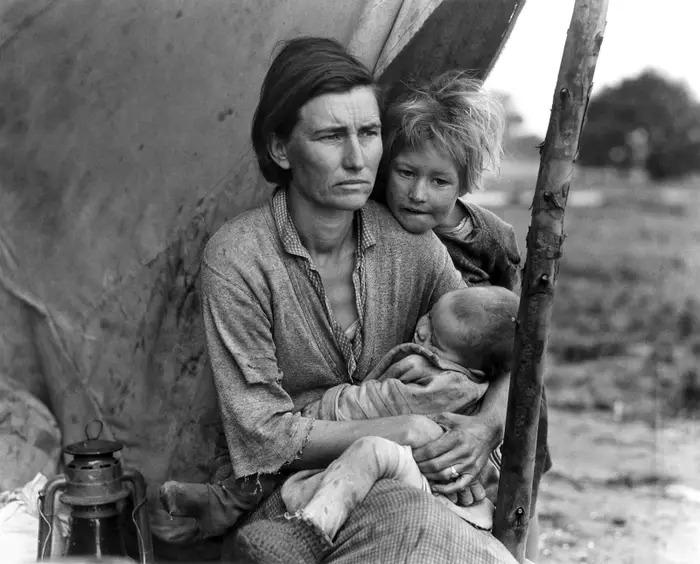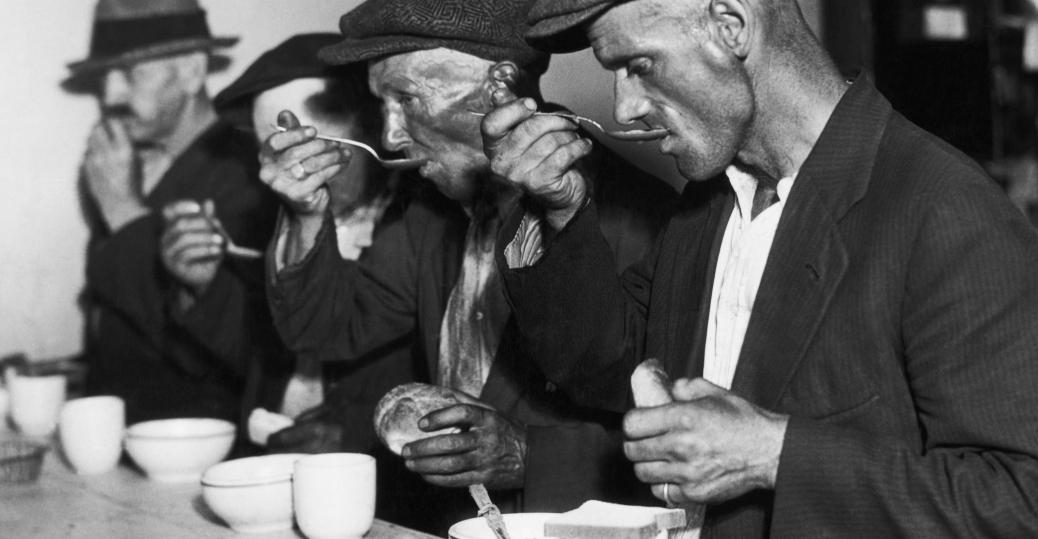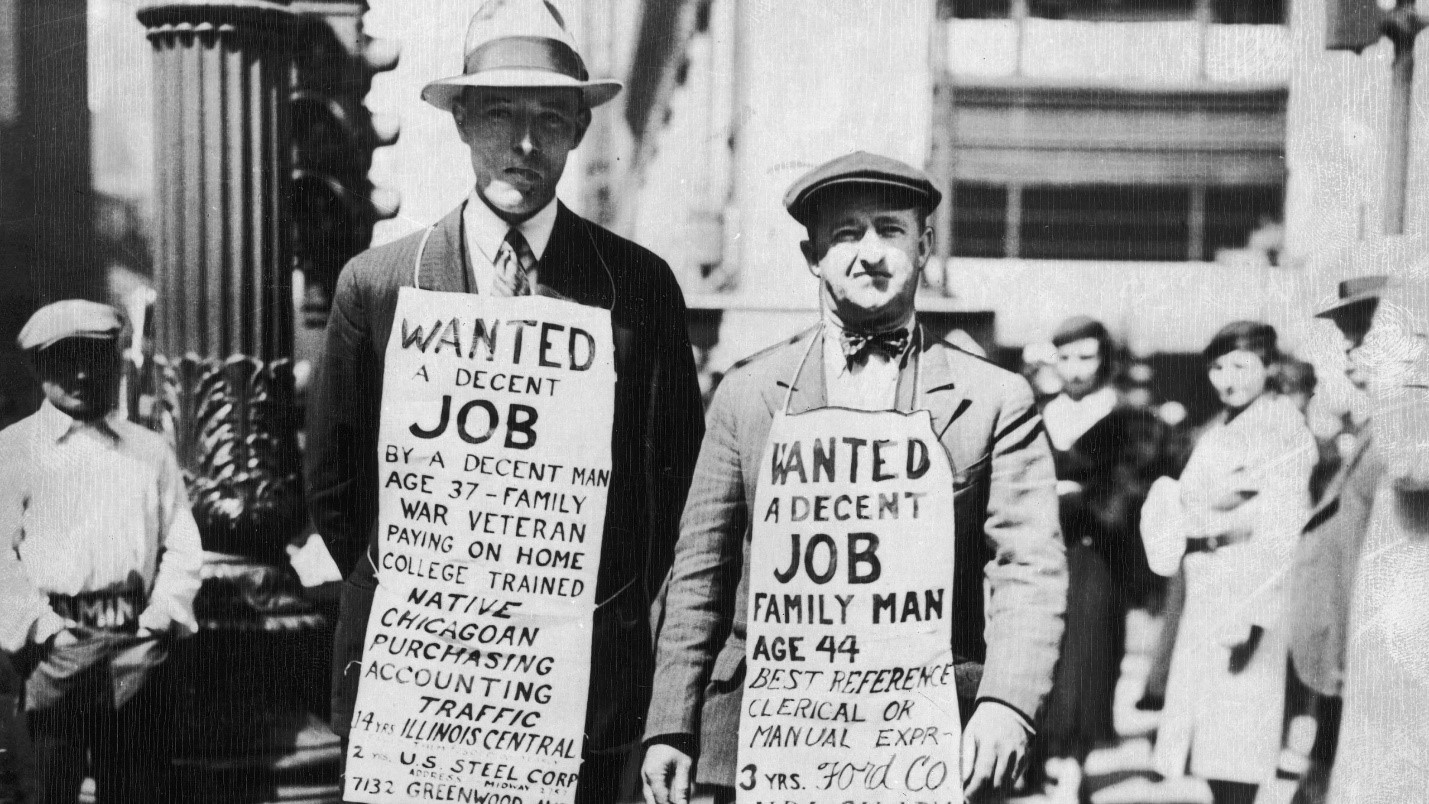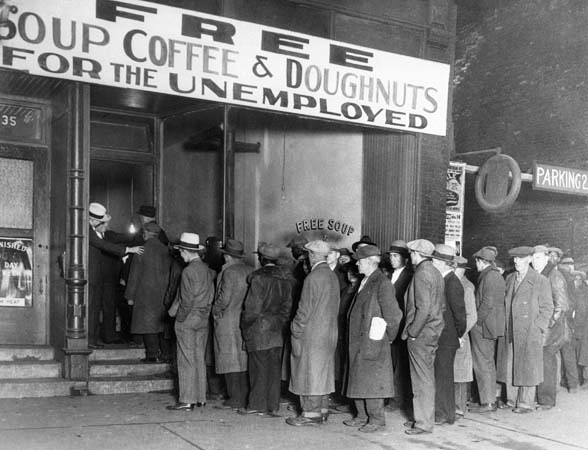
While millions of Americans are out of work and panic stricken as to how they are going to put food on the table, it is encouraging to remember how Americans responded to an even greater challenge three-quarters of a century ago. The example set by the “greatest generation” during our nation’s most severe crisis since the Civil War remains the bar to which we must strive to meet. Not only did they overcome the greatest economic downturn in modern history, but they defeated two “evil empires” thousands of miles from our shores. Undoubtedly, they are a shining example of what Americans can do if they remain resolute and stand united.
The Great Depression of the thirties remains the most important economic event in American history. This calamity caused enormous hardship for tens of millions of people and the failure of a large fraction of the nation’s banks, businesses, and farms. The Depression transformed national politics by vastly expanding government, which was increasingly expected to stabilize the economy and to prevent suffering. Democrats became the majority party. In 1929 the Republicans controlled the White House and Congress. By 1933, the Democrats had the presidency and, with huge margins, Congress (310-117 in the House, and 60-35 in the Senate). President Franklin Roosevelt’s New Deal gave birth to the American version of the welfare state. Social Security, unemployment insurance, and federal family assistance all began in the thirties.
It is hard for those who did not live through it to grasp the full force of the worldwide Depression. Between 1930 and 1939 U.S. unemployment averaged 18.2 percent. The economy’s output of goods and services (gross national product) declined 30 percent between 1929 and 1933 and recovered to the 1929 level only in 1939. Prices of almost everything (farm products, raw materials, industrial goods, stocks) fell dramatically. Farm prices, for instance, dropped 51 percent from 1929 to 1933. World trade shriveled: between 1929 and 1933 it shrank 65 percent in dollar value and 25 percent in unit volume. Most nations suffered. In 1932 Britain’s unemployment was 17.6 percent. Germany’s Depression hastened the rise of Hitler and, thereby, contributed to World War II.

The Depression is best understood as the final chapter of the breakdown of the worldwide economic order. The breakdown started with World War I and ended in the thirties with the collapse of the gold standard. As the Depression deepened, governments tried to protect their reserves of gold by keeping interest rates high and credit tight for too long. This had a devastating impact on credit, spending, and prices, and an ordinary business slump became a calamity. What ultimately ended the Depression was World War II. Military spending and mobilization reduced the U.S. unemployment rate to 1.9 percent by 1943.
With hindsight, it seems amazing that governments did not act sooner and more forcefully to end the Depression. The fact that they did not attests to how different people’s expectations and world politics were in the thirties. The Depression can be understood only in the context of the times. Consider four huge differences between then and now:
- The gold standard. Most money was paper, as it is now, but governments were obligated, if requested, to redeem that paper for gold. This “convertibility” put an upper limit on the amount of paper currency governments could print, and thus prevented inflation. There was no tradition (as there is today) of continuous, modest inflation. Most countries went off the gold standard during World War I, and restoring it was a major postwar aim. Britain, for instance, returned to gold in 1925. Other countries backed their paper money not with gold, but with other currencies—mainly U.S. dollars and British pounds—that were convertible into gold. As a result flexibility of governments was limited. A loss of gold (or convertible currencies) often forced governments to raise interest rates. The higher interest rates discouraged conversion of interest-bearing deposits into gold and bolstered confidence that inflation would not break the commitment to gold.
- Economic policy.Apart from the gold standard, economic policy barely existed. There was little belief that governments could, or should, prevent business slumps. These were seen as natural, therapeutic, and self-correcting. The lower wages and interest rates caused by slumps would spur recovery. The 1920-21 downturn (when industrial production fell 25 percent) had preceded the prosperous twenties. “People will work harder, live a more moral life,” Andrew Mellon, Treasury secretary under President Herbert Hoover, said after the Depression started. “Enterprising people will pick up the wrecks from less competent people,” he claimed. One exception to the hands-off attitude was the Federal Reserve, created in 1913. It was charged with the responsibility for providing emergency funds to banks so that surprise withdrawals would not trigger bank runs and a financial panic.
- Production patterns.Farming and raw materials were much more important parts of the economy than they are today. This meant that lower commodity prices could cripple domestic prosperity and world trade, because price declines destroyed the purchasing power of farmers and other primary producers (including entire nations). In 1929 farming accounted for 23 percent of U.S. employment (versus 2.5 percent today). Two-fifths of world trade was in farm products, another fifth in other raw materials. Poor countries (including countries in Latin America, Asia, and Central Europe) exported food and raw materials and imported manufactured goods from industrial nations.
- The impact of World War I.Wartime inflation, when the gold standard had been suspended, raised prices and inspired fears that gold stocks were inadequate to provide backing for enlarged money supplies at the new, higher price level. This was one reason that convertible currencies, such as the dollar and pound, were used as gold substitutes. The war weakened Britain, left Germany with massive reparations payments, and split the Austro-Hungarian Empire into many countries. These countries, plus Germany, depended on foreign loans (in convertible currencies) to pay for their imports. The arrangement was unstable because any withdrawal of short-term loans would force the borrowing countries to retrench, which could cripple world trade.
To view the Great Depression as the last gasp of the gold standard—as economic historians Barry Eichengreen and Peter Temin suggest—bridges the gap between two popular explanations. The best-known, advanced by economists Milton Friedman and Anna Schwartz in A Monetary History of the United States, 1867-1960, blames the Federal Reserve for permitting two-fifths of the nation’s banks to fail between 1929 and 1933 (or 10,797 of the 25,568 banks in 1929). Since deposits were not insured then, the bank failures wiped out savings and shrank the money supply. From 1929 to 1933 the money supply dropped by one-third, choking off credit and making it impossible for many individuals and businesses to spend or invest. Friedman and Schwartz argue that it was this drop in the money supply that strangled the economy. They consider the Depression mainly an American affair that spread abroad.

In contrast, economist Charles Kindleberger, in The World in Depression, 1929-1939, sees the Depression as a global event caused by a lack of world economic leadership. According to Kindleberger, Britain provided leadership before World War I. It fostered global trade by keeping its markets open, promoted expansion by making overseas investments, and prevented financial crises with emergency loans. After World War II the United States played this role. But between the wars no country did, and the Depression fed on itself, Kindleberger argues. No country did enough to halt banking crises, and the entire industrial world adopted protectionist measures in attempts to curtail imports. In 1930, for example, President Herbert Hoover signed the Smoot-Hawley tariff, raising tariffs on dutiable items by 52 percent. The protectionism put an extra brake on world trade just when countries should have been promoting it.
With the passage of time, both the Friedman-Schwartz and Kindleberger views seem correct. Inept monetary policy explains the Depression’s severity, as Friedman and Schwartz argue. But because the gold standard caused many governments to make similar errors, the effects were worldwide, as Kindleberger contends.
The start of the Depression is usually dated to the spectacular stock market crash of 1929. The Dow Jones industrial average hit its peak of 381 on September 3, up from 300 at the start of the year. After sporadic declines, the roof fell in on October 24 (Black Thursday). Stock prices dropped 15 to 20 percent before being supported by buying from a pool of bankers. Although the market closed with only a small loss (down 6 to 299), trading was nearly 12.9 million shares, about triple the normal volume. The selling panic resumed the next week. On Monday the Dow fell 38 points to 260, then the biggest one-day drop ever. The next day (Black Tuesday), it slid another 30 points. By November 13, the Dow was at 198.
There had been warnings. Many commentators complained before the crash that the market was driven by speculation. A lot of stock was bought on credit. Between the end of 1927 and October 1929, loans to brokers rose 92 percent. At the start of October, loans equaled nearly a fifth of the value of all stocks. But by itself the stock market crash did not cause the Depression. By year’s end the Dow Jones industrial average had actually rebounded to 248 (down 17 percent from the beginning of 1929). It continued rising in early 1930.
The Depression is often blamed on the passivity of President Hoover and the Federal Reserve. This view is simplistic. True, Hoover’s commitment to a balanced budget—the orthodoxy of the day—precluded big new spending programs. And his decision in 1932 to combat a budget deficit by raising taxes sharply is widely viewed as a major blunder. But it is not true that Hoover and the Federal Reserve stood idly by and did nothing as the Depression worsened. After the crash Hoover instituted a tax cut equal to 4 percent of federal revenues. He urged state and local governments to raise their spending on public works projects. Hoover also created the Reconstruction Finance Corporation, which provided loans to shaky banks, utilities, and railroads. In 1931 he suspended collection of foreign-debt payments to the United States, which he thought were impeding recovery of the international economy.
Nor was the Federal Reserve entirely passive. During the crash the Fed lent liberally to banks so they could sustain securities lending. Interest rates were allowed to drop rapidly. The discount rate (the rate at which the Federal Reserve lends to commercial banks) fell from 6 percent in October 1929 to 2.5 percent in June 1930. The money supply (cash in circulation plus checking and time deposits at banks) declined only slightly in the next year. Tighter Federal Reserve policy in 1928 and early 1929—intended to check stock market speculation—may have helped trigger the economic downturn. But the Federal Reserve was not stingy in early 1930 and was not driving the economy into Depression at that time. It was not until 1931 and later that the Federal Reserve failed to act as the “lender of last resort” and allowed so many banks to fail.
The truth is that, until the summer or early fall of 1930, almost everyone expected the economy to recover, just as it had in 1921. Unfortunately, almost everyone underestimated the forces pulling the economy down. One was the drop in trade that resulted from collapsing commodity prices. Kindleberger has argued that the price collapse was worsened by the stock market crash. The connection lay in a drying up of credit. Many loans used to buy stock had come from foreigners and big corporations, and they demanded repayment when stock prices plummeted. New York banks assumed some of the loans, but they cut loans to the importers of raw materials. Demand for these products (rubber, cocoa, coffee) dropped, and prices fell. Strapped for funds, countries that exported commodities reduced their imports of manufactured goods from industrial nations. The drop in trade was deepened by Smoot-Hawley, which provoked massive retaliation by other nations.
What made matters worse was a big drop in U.S. consumer spending—far more than can be explained by the stock market crash. The drop may have been a backlash to the rise of installment lending (for cars, furniture, and appliances) in the twenties. The prevailing practice allowed lenders to repossess an item if the borrower missed just one payment. People may have stopped making new purchases to reduce the risk of losing things they already had bought on credit. Whatever happened, the slump soon fed on itself. Weak spending depressed prices, which meant that many farmers, businesses, and nations couldn’t repay their debts. Rising bad debts prompted banks to restrict new loans and sell financial assets, usually bonds. Scarce credit led to less borrowing, less spending, lower prices, and more bankruptcies. Trade and investment spiraled downward. Confidence crumbled, and as it did, bank runs—people clamoring to convert deposits into cash—ensued.

Why could no one stop this spiral? In the United States there were waves of bank failures in 1931 and 1932. Friedman and Schwartz maintain that the Federal Reserve could have prevented them by lending directly to weak banks and by aggressive “open market” operations (that is, by buying U.S. Treasury securities and thereby injecting new funds into banks and the economy). This action would have halted the Depression, they argue. They blame the Federal Reserve’s timidity on the 1928 death of Benjamin Strong, the president of the Federal Reserve Bank of New York. Strong had dominated the Federal Reserve System, which consists of twelve regional banks and a board of governors in Washington. He firmly believed that the Federal Reserve had to prevent banking panics and sustain economic growth. When he died, power in the Federal Reserve passed to officials in Washington, whose ideas were murkier. Had Strong lived, Friedman and Schwartz contend, he would have averted the banking collapse.
Maybe—and maybe not. In fact, the Federal Reserve faced conflicting demands to end the Depression and to protect the gold standard. The first required easier credit, the second tighter credit. The gold standard handcuffed governments around the world. The mere hint that a country might abandon gold prompted speculators and international depositors to change local money into gold or a convertible currency. Deposit withdrawals spread panic and squeezed lending. It was a global process that ultimately forced all governments off gold. In May 1931 there was a run against Creditanstalt, a large Austrian bank. The panic then shifted to Germany and, in late summer, to Britain, which left gold in September.
The United States was trapped by the same forces. After Britain went off gold, for instance, the Federal Reserve raised interest rates sharply to stem gold outflows. The discount rate went from 1.5 to 3.5 percent, which, considering the condition of the economy, was a huge increase. The best evidence that the gold standard fostered the Depression is that once countries abandoned it, their economies usually began growing again. This happened in Germany, Britain, and, after Roosevelt left gold in March and April 1933, the United States.
Although self-defeating, the defense of gold was a product of law as well as custom. The Federal Reserve had to ensure that every dollar of paper money was backed by at least forty cents of gold. Once Congress ended the obligation to exchange gold for currency, the Fed was largely liberated from worrying about gold. This may have been the most important part of the New Deal’s economic program. The economy did improve. Between 1933 and 1937, the unemployment rate dropped from 25 to 14 percent before a new recession pushed it back up to 19 percent in 1938. The 1937-38 recession is widely blamed on the Federal Reserve’s mistaken decision to raise bank reserve requirements in August 1936 and early 1937. (Reserves are funds that banks keep as vault cash or as deposits at the Federal Reserve.)
Many economists now believe that the New Deal, apart from its gold policy, probably had little impact on economic activity. At the heart of the early New Deal were the National Recovery Administration (NRA) and the Agriculture Adjustment Act (AAA). Created in Roosevelt’s first hundred days, they sought to promote recovery by propping up prices. The idea was to improve incomes and halt bankruptcies. The AAA tried to eliminate agricultural surpluses (pigs were slaughtered, crops destroyed) and paid farmers not to plant. The NRA allowed companies in the same industry to set wages, prices, and working hours in an effort to check “destructive competition.” This approach rested on a remarkable contradiction: the way to get recovery, which requires more production, is to have less production. There never has been much evidence that it worked, and the Supreme Court found the NRA unconstitutional in 1935.
The New Deal did relieve suffering. Perhaps 10 million to 12 million Americans worked at some time on public works or in relief jobs (through the Public Works Administration, the Works Project Administration, and the Civilian Conservation Corps). People had their bank deposits protected with the advent of deposit insurance. The Securities and Exchange Commission regulated the stock market. Roosevelt maintained faith in democracy.
But there was a cost. The New Deal also caused suffering. Sharecroppers were often thrown out of work, for example, when the AAA paid landowners not to grow. The New Deal also fostered class consciousness. Roosevelt increasingly blamed the Depression on the wealthy—”economic royalists,” as he called them. The loss of business confidence in government policies may have deterred new investment, offsetting any economic stimulus of higher public spending. But by 1933 the economy had been so ravaged that only a partial recovery may have been possible until the huge wartime boom.
The Depression left an enormous legacy. The New Deal accustomed people to look to government, rather than to private charity, for help. After World War II, governments everywhere strove to prevent a repetition of the Great Depression. Economic policies became more active and, as a practical matter, more inflationary. With the gold standard gone, governments had more freedom to stimulate their economies with an expansion of money and credit. The political inclination was to act sooner, rather than later, to halt a slump. Likewise, the protectionism of the thirties prompted postwar efforts to reduce tariffs and other trade barriers. Finally, the wild swings of exchange rates that occurred after countries went off gold spurred the creation of the Bretton Woods system of fixed exchange rates in 1944. This system (named after a resort in New Hampshire where the agreement was finalized) stipulated that currencies were to maintain fixed exchange rates with the dollar. The system broke down in the early seventies.
It is commonly said that another Depression will never occur. This is probably true, as long as “another Depression” means a crude repetition of the thirties. However, crises can come in unfamiliar forms. The basic lesson from the Great Depression is that governments cannot permit massive collapses of banks or spending. The deeper lesson is that there are times when the world changes so much and events move so rapidly that even the well-informed do not know how to respond. This is the story of the Depression. Now it seems preventable. Then, it was baffling. World War I made restoration of the prewar economic system difficult, maybe impossible. But that is what world leaders attempted because it was all they knew and it had worked. Only its collapse convinced them to try something different. Old ideas were overtaken and overwhelmed. It has happened before—and could again.
About the Author
Robert J. Samuelson is a journalist who writes a column on economic affairs for Newsweek, the Washington Post, and other newspapers.
Further Reading
Allen, Frederick Lewis. Since Yesterday: The 1930s in America. 1939.
Eichengreen, Barry. Golden Fetters: The Gold Standard and the Great Depression. 1992.
Friedman, Milton, and Anna Jacobson Schwartz. A Monetary History of the United States, 1867-1960. 1963.
Kindleberger, Charles P. The World in Depression, 1929-1939. Revised and enlarged edition. 1986.
Lewis, W. Arthur. Economic Survey, 1929-1939. 1949.
Saint-Etienne, Christian. The Great Depression, 1929-1938, Lessons for the 1980s. 1984.
Temin, Peter. Lessons from the Great Depression. 1989.
Wigmore, Barrie A. The Crash and Its Aftermath, A History of Securities Markets in the United States, 1929-1933. 1985.
